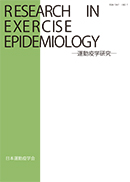Objective: To examine psychosocial determinants associated with sports injury severity in judo as well as track and field sports.
Methods: A questionnaire survey was conducted with male and female university judo players (n=793) and track-and-field athletes (n=655), who were identified using the snowball sampling. The questionnaire included the following items; the state of sports injuries, competition records, individual traits, coping resources, health-related issues, and stress responses. The questionnaire was conducted twice within a one-year interval. Responses of participants without sports injuries were analyzed in the first survey (judo: n=222, track-and-field: n=191). Multinomial logistic regression analysis was conducted on each type of sport with the states of injuries after one year (uninjured, mildly injured, and severely injured) as objective variables and standardized psychosocial determinants at the first survey as explanatory variables, by adjusting for gender, age, competition records, and duration of past injuries.
Results: In the second survey conducted after one year, the incidence of mild and severe injuries was 40 (18%) and 20 (9%) for judo players, 14 (7%) and 18 (9%) for track-and-field athletes. Multivariate analysis was conducted, and adjusted odds ratios[95%CI] compared to the uninjured judo players were as follows; the sense of authenticity=.49[.27-.90] in the mildly injured group, acquired resilience=2.26[1.03-4.98], problem-solving behavioral traits=2.86[1.30-6.27], and reduced mental health=3.26[1.41-7.54] in the severely injured group (p <.05). On the other hand, adjusted odds ratios compared to the uninjured track-and-field athletes’ group were as follows; self-confidence for health management =.32[.13-.77] in the mildly injured group, innate resilience=.36[.14-.91] and acquired resilience=2.60[1.08-6.25] in the severely injured group (p <.05).
Conclusion: It was indicated that factors related to the occurrence of sports injuries differed based on the types of sports and the degree of severity. Moreover, it was suggested that acquired resilience might increase the risk of having severe injuries in both types of sports.
View full abstract
 2019Volume 21Issue 2 Pages 148-159
2019Volume 21Issue 2 Pages 148-159